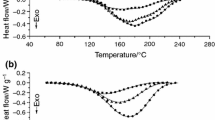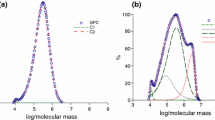Abstract
The thermal degradation of thermally cured vinyl ester resin systems is studied for different heating rates. The kinetic triplets, the activation energy, pre-exponential factor and the reaction model f(α) for the different reaction extent of conversions (α) are estimated using advanced isoconversional methods. Although the thermal degradation curves show the degradation occurs as a single stage, the kinetic parameters suggest the otherwise. The activation energy remains constant for α = 0.3–0.575 but varies during the initial and final stages of conversion. Similarly, the pre-exponential factor shows considerable variation between the lower and higher reaction extent (α) values. This shows the complexity in the reaction. The probable reaction mechanism that the degradation follows has been explained. The complexity of the thermal degradation and the changes in reaction model f(α) over different reaction extent has been related. The appropriate working temperature for different thermal lifetime of the cured vinyl ester resin system for the failure of conversion α = 0.2 has been predicted under the nitrogen atmosphere.










Similar content being viewed by others
References
Lubin B. Handbook of composites. New York: Van Nostrand Reinhold; 1984.
May CA. Epoxy resin chemistry and technology. New York: Marcel Dekker; 1988.
Vimalathithan PK, Vijayakumar CT. Characterization of cenosphere-reinforced vinyl ester composites. J Elastom Plast. 2017. https://doi.org/10.1177/0095244317708591.
David C. Thermal degradation of polymers: in comprehensive chemical kinetics. In: Bamford CH, Tipper CFH, editors. Degradation of polymers, vol. 14. Amsterdam: Elsevier; 1975. p. 1.
Vyazovkin S, Burnham AK, Criado JM, Pérez-Maqueda LA, Popescu C, Sbirrazzuoli N. ICTAC Kinetics Committee recommendations for performing kinetic computations on thermal analysis data. Thermochim Acta. 2011;520:1–19.
Brown ME, Maciejewski M, Vyazovkin S, Nomen R, Sempere J, Burnham A, Opfermann J, Strey R, Anderson HL, Kemmler A, Keuleers R, Janssens J, Desseyn HO, Li CR, Tang TB, Roduit B, Málek J, Mitsuhashi T. Computational aspects of kinetic analysis. Part A: the ICTAC kinetics project: data, methods, and results. Thermochim Acta. 2000;355:125–43.
Vyazovkin S, Wight CA. Isothermal and non-isothermal kinetics of thermally stimulated reactions of solids. Int Rev Phys Chem. 1998;17(3):407–33.
Doyle CD. Estimating isothermal life from thermogravimetric data. J Appl Polym Sci. 1962;24:639–42.
Garn PD, Hulber S. Kinetic investigations by techniques of thermal analysis. Anal Chem. 1972;3:65–111.
Vyazovkin S, Wight CA. Model-free and model-fitting approaches to kinetic analysis of isothermal and nonisothermal data. Thermochim Acta. 1999;340:53–68.
Vyazovkin S. Model-free kinetics. Staying free of multiplying entities without necessity. J Therm Anal Calorim. 2006;83:45–51.
Friedman H. Kinetics of thermal degradation of char-forming plastics from thermogravimetry—application to a phenolic resin. J Polym Sci Part C Polym Lett. 1964;6:183–95.
Flynn JH, Wall LA. A quick, direct method for the determination of activation energy from thermogravimetric data. J Polym Sci Part B Polym Lett. 1966;4(5):323–8.
Kissinger HE. Reaction kinetics in differential thermal analysis. Anal Chem. 1957;29(11):1702–6.
Doyle CD. Kinetic analysis of thermogravimetric data. J Appl Polym Sci. 1961;5(15):285–92.
Coats AW, Redfern JP. Kinetic parameters from thermogravimetric data. Nature. 1964;201(4914):68–9.
Vyazovkin S. Modification of the integral isoconversional method to account for variation in the activation energy. J Comput Chem. 2001;22(2):178–83.
Vyazovkin S, Wight CA. Estimating realistic confidence intervals for the activation energy determined from thermoanalytical measurements. Anal Chem. 2000;72:3171–5.
Flynn JH. The ‘temperature integral’—its use and abuse. Thermochim Acta. 1997;300:83–92.
Starink MJ. The determination of activation energy from linear heating rate experiments: a comparison of the accuracy of isoconversion methods. Thermochim Acta. 2003;404:163–76.
Urbanovici E, Segal E. Some problems concerning the temperature integral in non-isothermal kinetics part II: a new criterion to compare the accuracy of various approximations. A third order rational approximation. Thermochem Acta. 1991;178:223–9.
Urbanovici E, Popescu C, Segal E. On the accuracy of Senum and Yang’s fourth degree rational approximation of the temperature integral. J Therm Anal Calorim. 1999;55:325–7.
Cai J, Liu RH. New approximation for the general temperature integral. J Therm Anal Calorim. 2007;90:469–74.
Farjas J, Roura P. Isoconversional analysis of solid state transformations. A critical review. Part I. Single step transformations with constant activation energy. J Therm Anal Calorim. 2011;105:757–66.
Šesták J, Berggren G. Study of kinetics of the mechanisms of the solid-state reactions at increasing temperatures. Thermochim Acta. 1971;3:1–12.
Vyazovkin S. Kinetic concepts of thermally stimulated reactions in solids: a view from a historical perspective. Int Rev Phys Chem. 2000;19(1):45–60.
Hefczyc B, Siudyga T, Zawadiak J, Mianowski A. Analysis of the thermal decomposition of azo-peroxyesters by Arrhenius-type and three-parameter equations. J Therm Anal Calorim. 2011;105:981–6.
Šimon P. Fourty years of Šesták–Berggren equation. Thermochim Acta. 2011;520:156–7.
Šesták J. Philosophy of non-isothermal kinetics. J Therm Anal. 1979;16:503–20.
Gorbachev VM. Some aspects of Šesták’s generalized kinetic equation in thermal analysis. J Therm Anal. 1980;18:193–7.
Pérez-Maqueda LA, Criado JM, Sánchez-Jiménez PE. Combined kinetic analysis of solid-state reactions: a powerful tool for the simultaneous determination of kinetic parameters and the kinetic model without previous assumptions on the reaction mechanism. J Phys Chem A. 2006;110:12456–62.
Sánchez-Jiménez PE, Pérez-Maqueda LA, Perejón A, Criado JM. A new model for the kinetic analysis of thermal degradation of polymers driven by random scission. Polym Degrad Stab. 2010;95:733–9.
Shahcheraghi SH, Khayati GR, Ranjbar M. An advanced reaction model determination methodology in solid-state kinetics based on Arrhenius parameters variation—part I: thermal dehydration kinetic analysis of Cu4SO4(OH)6. J Therm Anal Calorim. 2015;122:175–88.
Shahcheraghi SH, Khayati GR, Ranjbar M. An advanced reaction model determination methodology in solid-state kinetics based on Arrhenius parameters variation—part II: validation and application to crystallization of amorphous Cu4SO4(OH)6. J Therm Anal Calorim. 2016;126:981–3.
Shahcheraghi SH, Khayati GR, Ranjbar M. An advanced reaction model determination methodology in solid-state kinetics based on Arrhenius parameters variation—part III: thermal desulfurization kinetic analysis of CuO.CuSO4. J Therm Anal Calorim. 2016;123:221–9.
Toop DJ. Theory of life testing and use of thermogravimetric analysis to predict the thermal life of wire enamels. IEEE Trans Electr Insul. 1971;6:2–14.
Cai J, Chen S. A new iterative linear integral isoconversional method for the determination of the activation energy varying with the conversion degree. J Comput Chem. 2009;30(13):1986–91.
Trache D, Abdelalziz A, Siouani B. A simple and linear isoconversional method to determine the pre-exponential factors and the mathematical reaction mechanism functions. J Therm Anal Calorim. 2017;128:335–48.
Bassyouni M, Ali I, Abdel-Hamid SMS. Study of thermo-kinetic properties of graphite micro-platelet-enriched vinyl ester composites. J Therm Anal Calorim. 2018;131:1055–65.
Author information
Authors and Affiliations
Corresponding author
Rights and permissions
About this article
Cite this article
Vimalathithan, P.K., Barile, C. & Vijayakumar, C.T. Investigation of kinetic triplets for thermal degradation of thermally cured vinyl ester resin systems and lifetime predictions. J Therm Anal Calorim 133, 881–891 (2018). https://doi.org/10.1007/s10973-018-7154-6
Received:
Accepted:
Published:
Issue Date:
DOI: https://doi.org/10.1007/s10973-018-7154-6




